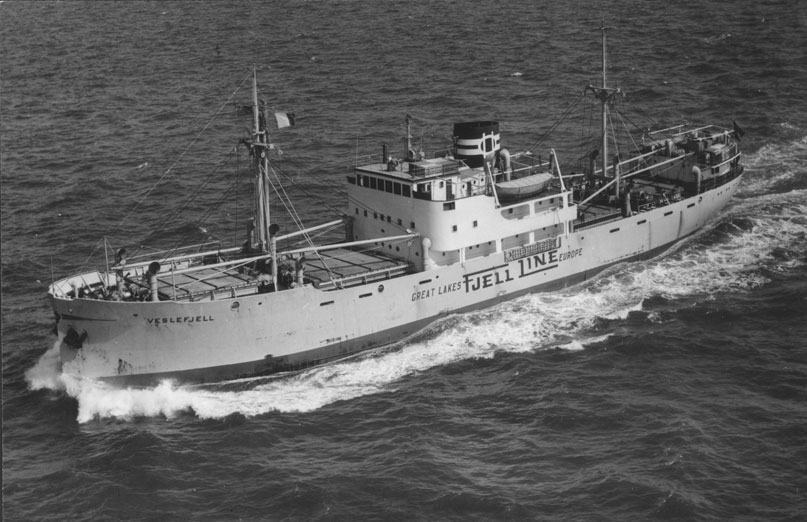
Shipwreck: Veslefjell Sailed on the Lakes and Oceans
by Skip Gilham, Vineland, Ontario, Canada |
The Norwegian firm of Olsen and Ugelstad dates back to 1915, when they began trading with the wooden sailing ship Superb. The company continued to expand gradually, adding steel steamers. Their initial service was in and around Norway, but despite the Depression, they began coming to the Great Lakes in 1932.
Their early transatlantic freighters had been designed for the North Sea coal trade or for work on the Baltic, and they were not really equipped for service to North America. Two new ships for this trade were completed in 1935 and three more in 1936. The firm became commonly known as the "Fjell Line" due to the names of their ships ending in "fjell"..
The company pioneered liner trading to the Great Lakes but their success was interrupted by World War Two. It resumed in 1948, and they continued to add package freight carriers designed to accommodate the small locks of the pre-Seaway system.
Among the new postwar carriers was the Veslefjell. The 258 foot, 7 in long by 42 ft, 7 in wide freighter was built at Frediksstad, Norway, in 1951, and was soon traveling to the inland seas. During the winter months the ship delivered their Canadian cargoes to Saint John, New Brunswick, and Halifax, Nova Scotia.
The opening of the St. Lawrence Seaway on April 25, 1959, allowed ships up to 730 feet long by 75 feet wide to enter the Great Lakes, so freighters like Veslefjell became less competitive. The owners sent this ship to John Crown & Sons at Sunderland, England, in May 1960, and it was lengthened to 287 feet, 4 inches. This increased the carrying capacity from 2,745 to 3,355 tons deadweight.
Beginning in 1959, Veslefjell made eleven trips to the Great Lakes, and these voyages continued until the ship was sold in May, 1962. Renamed Sea Carrier, it operated under British registry but reverted to Olsen & Ugelstad in May, 1964, and reacquired the former name. It was resold to Greek interests in June, 1965, and became Asteri for Seaways Co. Inc. It was again sold to Titramar, Inc. in 1969, and they applied the name of Marlen. A final sale in 1975 took the ship to Baru Shipping Co. (Panama) SA., although registry remained at Piraeus, Greece.
Marlen's final cargo proved to be a load of cement that came aboard at Aegion in January, 1978, for Nigeria. The ship encountered heavy seas in an Atlantic storm shortly after passing Gibraltar and the stress on the 27-year old hull eventually led to the development of leaks. On January 21, the pumps could no longer compete and the vessel was abandoned by the crew in position 29.47 N / 11.49 W. The ship was last seen, low in the water, northeast of the Canary Islands, at 30.01 N / 11.37 W and was presumed to have sunk.
Photo: SkyfotosPage last modified: